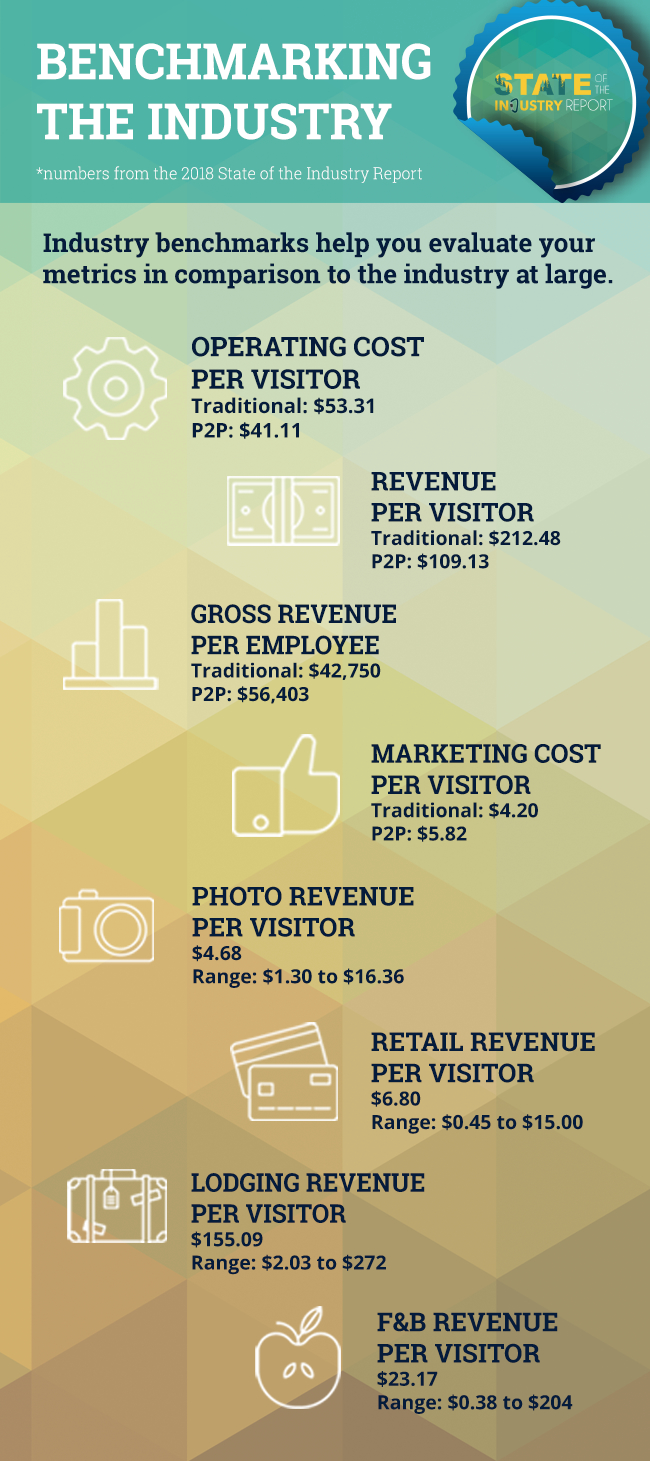 Industry benchmarks help you evaluate your metrics in comparison to the industry at large. And that can help you pinpoint your strengths and identify areas for growth in your various revenue streams.
Industry benchmarks help you evaluate your metrics in comparison to the industry at large. And that can help you pinpoint your strengths and identify areas for growth in your various revenue streams.
To make that possible, though, operators must participate in a broad data collection process, such as our annual State of the Industry survey. We encourage you to track your business using the metrics we describe in “The Metrics That Matter” and report these in the survey, which we will conduct in the fall.
What type of metrics do you benchmark?
Benchmarking is a helpful tool for many metrics one might use to gauge the relative success of your operation, both in expenses and revenue. Establishing costs and earnings per visitor can be utilized not only in benchmarking against industry averages but also in determining your operations pricing, budgeting, and more.
For example, if your operating cost per visitor is $41.11 (which, incidentally, is the P2P industry average according to respondents in the 2018 State of the Industry Report), then you must price your tickets accordingly to cover those costs and turn a profit. Your cost per visitor is an especially important metric to be aware of prior to offering discounted tickets.
What are the industry benchmarks I can compare to?
The 2018 State of the Industry Report, which reflects the numbers provided by 130-plus respondents, is one of the best sources of benchmarking data.
For example: for aerial businesses reporting both revenue and visitation numbers, traditional operations averaged $212.48 per visitor, while P2P operations averaged $109.13 per visitor. Additionally, traditional respondents reported an average of $42,750.79 of revenue per employee, while P2P respondents averaged $56,403.38 of revenue per employee.
It comes as no surprise that the most common source of revenue across the industry is from tickets/activities, which account for roughly 75% of revenues. Among other revenue sources, several ancillary products and amenities have the potential to be significant revenue streams, from retail to food and beverage.
For operations reporting this data, photo services made up an average of 6% of their revenue. On average, photo services earned those operations $4.68 per visitor.
Retail poses a similar opportunity. For those operators reporting this data, retail made up an average of 6.5% of their revenue, earning an average of $6.80 per visitor.
Food and beverage services are becoming increasingly common. Some operators offer full-service restaurant options, while others offer pre-packaged snacks and bottled drinks. Combined, responding operations that offer food and beverage report that these brought in an average of 10% of the total revenue, an average of $12.33 per visitor.
Events are another major source of revenue for operators that focus on them. Though not many operators offer a full events calendar, those who do typically name events as their number-one source of “other” revenue.
Operations that maintain lodging facilities find that these contribute a significant portion of their income. Those reporting lodging revenue as a separate line item indicated that it made up an average of 35% of their revenue, at $155.09 per visitor on average.
(Note: lodging revenues may reflect multi-day stays.)
These benchmarks can help you determine how much opportunity you may have for growth in your various revenue streams. For example, the reported range for retail sales is $0.45 to $15 earned per visitor. Operators at the lower end of that spectrum may well have opportunity for retail growth by exploring alternative products, pricing strategies, etc.
We encourage all operators to track their metrics and participate in the 2019 State of the Industry survey, which will take place in fall 2018. The more operators that participate, the better the data is, and the more it can support your operation and the industry as a whole.






